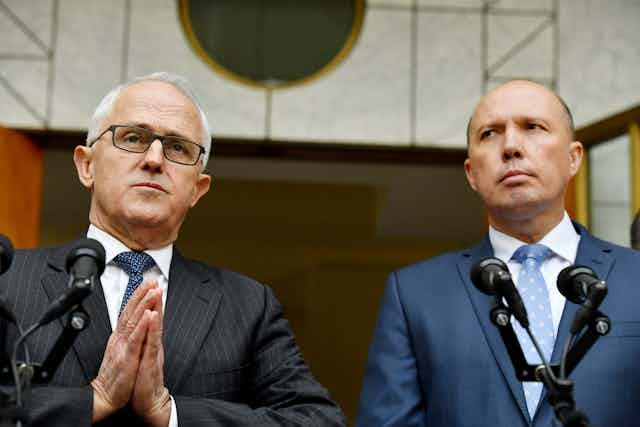It is difficult not to give in to cynical impulses over Tuesday’s announcement that the government will create a Department of Home Affairs.
Described as a “federation of border and security agencies”, the home affairs minister – set to be the current immigration minister, Peter Dutton – will be responsible for ASIO, the AFP, Border Force, the Australian Criminal Intelligence Commission, the Australian Transaction Reports and Analysis Centre, and the Office of Transport Security.
The Home Affairs department was announced at the same time the government released an eagerly awaited review of Australia’s intelligence agencies. But the rationale for the creation of a “super ministry” seems to conflate the well-intentioned and important intelligence review with an inadequately justified yet major rearrangement of federal government executive agencies.
Fraught with danger
The Home Affairs model appears to stand on contestable grounds.
There may be an argument to be made about potentially improving internal bureaucratic efficiencies by having power centralised under one minister. However, this is debatable. And the move upends long-standing conventions on how security intelligence and executive police powers are managed separately.
Bringing ASIO and the AFP together in one department and away from the attorney-general is a fraught move.
Multiple royal commissions and a protective security review following the Hilton Hotel bombing in February 1978 saw the police, security and intelligence functions tried and tested by fire. They were found wanting, but were then subject to significant review and reform.
That reform led to an understanding about how best to delineate and maintain the separation of powers while upholding robust accountability. That understanding has come to be broadly accepted as the best way of managing intelligence and security affairs.
This model includes a high degree of healthy contestability concerning intelligence judgements and operational options. This is thanks in large part to the diffusion of power between ministries, and authority between agencies, departments and ministers. These arrangements mean there are clear lines of accountability and responsibility.
Mechanisms for prioritisation and avoiding overlap exist with the Heads of Intelligence Agencies Meetings, the Secretaries Committee on National Security, cabinet’s National Security Committee, and the National Intelligence Collection Requirement Priorities mechanisms. It’s unclear how the new arrangements will alter the dynamics in these contexts.
Under the previous arrangements, in authorising a warrant the attorney-general had to be satisfied it was justified, recognised as consistent with agreed-upon national intelligence collection priorities, resourced appropriately, executed within the legal guidelines, and then suitably reported on in a timely manner.
Under the new arrangements, the attorney-general – having relinquished management responsibility for ASIO – will retain responsibility for issuing warrants and ministerial authorisations. Yet the attorney-general will not, seemingly, be responsible for seeing the process through to its completion.
This change risks diminishing the prospects of a clear connection between ministerial authority and ministerial responsibility. The two functions look set to be performed separately, by the attorney-general and the home affairs minister.
The attorney-general also will gain responsibility for two important oversight agencies: the Independent National Security Legislation Monitor and the Inspector-General of Intelligence and Security. These are two little-understood but important offices that have been performing significant roles to ensure intelligence agencies are accountable and compliant with legislation.
The inspector-general, for instance, has the enduring powers of a royal commissioner. They are able to walk into any sensitive intelligence facility and ask to see any files virtually at any time.
Like the monitor, the inspector-general can report directly to the prime minster. This is a powerful tool to ensure accountability. It is hard to think of a compelling reason for their lines of reporting responsibility to be altered.
What role did the intelligence review play?
Announcing the changes on Tuesday, Prime Minister Malcolm Turnbull did not speak about the intelligence review – undertaken by former senior public servants Michael L'Estrange and Stephen Merchant – in great detail.
However, Turnbull did mention the headline items. These include:
the creation of an office of national intelligence (a sensible and graduated move);
the better resourcing and management of intelligence capabilities (also a reasonable step);
the establishment of the Australian Signals Directorate as a statutory body within the Department of Defence (something talked about for years by insiders); and
a bolstering of the profile and placement of the Australian Cyber Security Centre (an unsurprising step given the high profile of cyber affairs this year).
The review also proposed:
an expansion of the Inspector-General of Intelligence and Security’s remit to cover agencies with intelligence collection and reporting functions not previously counted as part of the six agencies in the Australian Intelligence Community over which he exercised oversight; and
a slightly expanded, operationally-oriented role for the Parliamentary Joint Committee on Intelligence and Security to request briefings and initiate inquiries.
These recommendations are sound. But they were made in isolation of the Home Affairs proposal.
By announcing the review and the new arrangements together, the issues appear conflated. The Intelligence review is well considered and reasonable. The new governance arrangements lack the same level of intellectual rigour for the public to consider and accept.
Put together, it suggests this is more about politics than substantive fact-based organisational reform.

